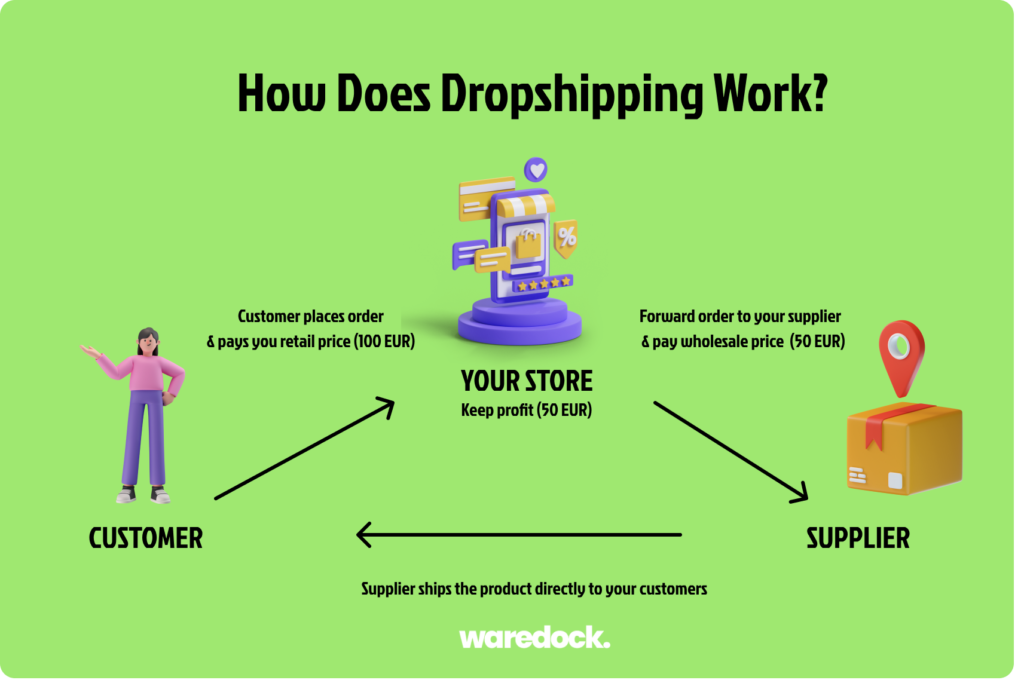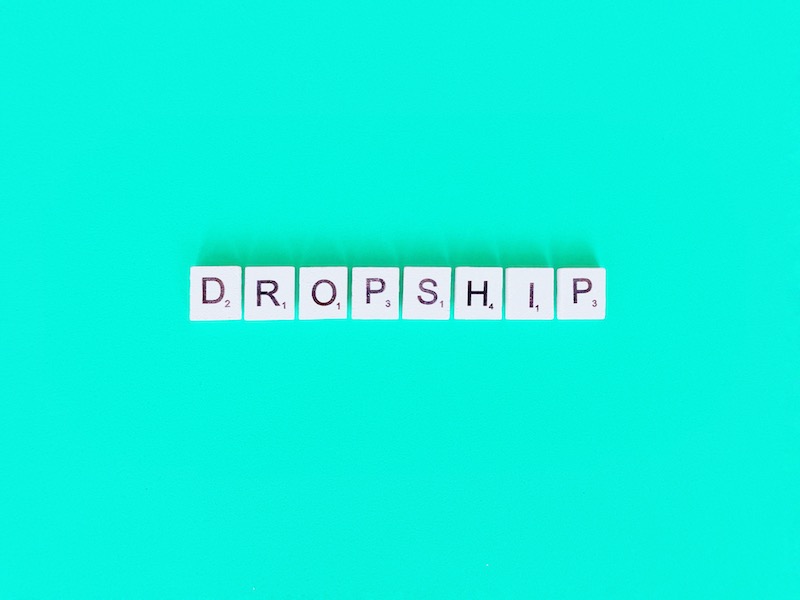Table of Contents
What Is Dropshipping?
Dropshipping (or drop shipping — both are correct) is a process of product fulfillment that occurs when items are shipped directly from the manufacturer or wholesaler to the customer. A third-party retailer facilitates drop shipping by placing items for sale on its website. The retailer pays for inventory only after a customer buys the item on its sales platform. In this business model, the manufacturer or distributor, not the retailer, takes responsibility for warehousing and eCommerce fulfillment.
The practice of dropshipping was first introduced around 1928 but lost momentum during the Great Depression. Later, in the 1950s, Toyota implemented a just-in-time (JIT) supply chain system. Dropshipping meaning has evolved with time, and the modern business model takes the concept further by eliminating the high costs of inventory transportation and storage for retailers.

How Does Dropshipping Work?
When a customer orders through your website, your sales automation software routes it to your drop shipping manufacturer, distributor, or wholesaler to be packed and shipped, removing the most expensive component of the traditional brick-and-mortar business model.
Although you may expect the drop shipper to be the manufacturer of the product in question, wholesalers also drop ship products and even offer customization. For example, let’s say you start an apparel brand that sells printed t-shirts. You could go the traditional route, ordering hundreds of shirts with your designs screen printed, but you risk some of your designs not selling well or at all. Instead, you could work with a dropshipping partner that offers on-demand t-shirt printing. When a customer orders one of your t-shirt designs, the order goes to your partner to print and fulfill. You don’t have to stock shirts, worry about which sizes to buy, or pay for printing until you sell a shirt.
10 Benefits Of The Dropshipping Business Model
The drop ship business model is a popular way of selling goods online without holding inventory or managing the fulfillment process. Some benefits of this model include:
- Lower Startup Costs: With drop shipping, you don’t need to purchase inventory upfront, which means you can start your business with lower capital.
- Reduced Risk: Since you don’t need to buy inventory upfront, there is less risk of having unsold products or being stuck with dead stock.
- Flexibility: As a drop shipper, you can sell a wide range of products from different suppliers without the need to hold inventory or manage logistics.
- Scalability: As your business grows, you can easily add more products to your store without worrying about managing additional inventory.
- Time-saving: Since you don’t need to handle inventory, packaging, and shipping, you can focus on marketing and growing your business.
- Access to a Wide Range of Products: As a drop shipper, you can offer a broad range of products from different suppliers without worrying about stocking inventory.
- Location Independence: You can run a drop shipping business from anywhere with an internet connection, making it an excellent option for digital nomads and remote workers.
- Higher Profit Margins: With drop shipping, you can earn higher profit margins since you don’t have to pay for inventory upfront or manage logistics.
- Easy to Test Products: You can test new products without buying inventory upfront, which allows you to validate demand before committing to a large purchase.
- No Warehouse or Storage Space Required: Since you don’t hold inventory, you don’t need to worry about renting storage space or managing a warehouse.
10 Risks and Challenges Of The Drop Ship Business Model
While there are many benefits to the drop shipping business model, there are also some risks and challenges that you should be aware of:
- Supplier Errors: Since you’re relying on suppliers to fulfill orders, there is a risk that they might make mistakes or experience delays that could impact your customers’ satisfaction and your reputation.
- Lack of Quality Control: When you’re not handling the products yourself, you have less control over the quality of the products that are being shipped to your customers.
- Shipping Issues: If a supplier doesn’t ship products in a timely manner or uses a low-quality shipping service, it could result in delayed or lost shipments.
- Profit Margins: While drop shipping allows you to earn higher profit margins, you also have to consider the cost of shipping and handling, which can eat into your profits.
- Competition: Drop shipping is a popular business model, which means there is a lot of competition in the market. You’ll need to find unique products or niches to stand out from the crowd.
- Inventory Management: While you don’t have to manage inventory, you still need to keep track of supplier stock levels and availability to ensure you don’t sell products that are out of stock.
- Customer Service: As the face of the business, you are responsible for customer service and handling any complaints or issues that arise, even if they’re related to the supplier’s error.
- Lack of Branding Control: Since you’re not handling the products yourself, you have less control over the packaging and branding, which could impact how customers perceive your brand.
- Legal Issues: Drop shippers need to ensure they comply with relevant regulations and laws in their country or region, including taxes and import/export regulations.
- Difficulty in Establishing Relationships with Suppliers: It can be challenging to find reliable suppliers and establish a good relationship with them. Some suppliers may require minimum orders or charge higher fees for drop shipping services
Dropshipping Myths Exposed
When you research the best model to use to start an eCommerce business, you will find no shortage of people trying to convince you their methods will mint you an easy fortune. But most of the self-help gurus and business coaches have made their money selling services, not products, to consumers. Advice from eCommerce business “experts” has created interest in dropshipping but also led to misperceptions about the business model.
Dropshipping Is A Passive Income Machine
It’s a common belief that dropshipping is a good way to get rich quick. Unfortunately, this is not the case. It’s true that dropshipping makes it easy to list products for sale on your site, but you still need to attract enough traffic to support your desired sales volume. Building a brand that consumers trust can take a substantial advertising budget and a lot of time in the crowded online retail space.
Plus, once you get consumers to your site, you need clear, appealing product listings, competitive pricing, and an easy-to-navigate checkout process to drive conversions.
You Can Eliminate The Middleman
Although it is often the case that a drop shipper is also the manufacturer, some wholesale distributors will also drop ship products purchased from manufacturers. These wholesalers add their cut to the manufacturer’s unit cost, leading to a higher wholesale price for you. A distributor or wholesaler middleman can be an attractive partner if it handles returns, offers customization services, gives you a wider range of products to choose from, or adds value in another way.
You Cannot Customize Drop Shipped Products
Another common myth of dropshipping is that your products will be indistinguishable from those of your competitors who partner with the same supplier. Although drop shipped products are usually standardized, some suppliers offer customization. Your manufacturer might even be able to offer the custom experience you envision for your customer.
All Third-Party Fulfillment Services Are Drop Shippers
You may assume that all fulfillment or 3PL companies offer dropshipping services, but this is not true. A 3PL, or third-party logistics provider, is a company that handles storage, order fulfillment, and shipping for eCommerce companies. In general, fulfillment companies do not take on the risk of owning the inventory, so you’re more likely to find a drop-ship partner that is a manufacturer.
Looking for A Dropshipping Fulfillment Partner?
Dropshipping has become a very popular model for ecommerce. Also, dropshipping as a remedy to inventory shortages can be an active supply chain strategy. Waredock is able to procure items from your existing suppliers on your behalf, arrange dropship price agreements, take care of the shipping and track & trace, and even source additional product categories that are a good fit for your existing portfolio.
Is Dropshipping The Right Business Model?
When starting a physical product enterprise, you have many business models to choose from. Your target product niche, markets, and budget will determine the optimal approach to building your company.
Here are a few alternatives to the drop ship business model that every aspiring eCommerce entrepreneur should consider.
Original Product Development
If you have a genius idea for a new product, you’ll need to set up a manufacturing supply chain to deliver your merchandise to market. Expect to invest substantial capital in developing a finished product, manufacturing stock, and building up inventory. You’re not likely to find a dropshipping partner willing to take on the expense and risk of manufacturing and storing an untested product.
Retail Arbitrage
In economics, arbitrage is the practice of profiting from the difference between the purchase and sale price of an asset. Retail arbitrage is the exploitation of a price discrepancy between various supply channels. For example, if customers on eBay are willing to pay $2 for a product you can purchase from a dollar store, you make $1 on the sale from retail arbitrage. Amazon arbitrage is one popular example of this online retail strategy.
Private Label Brand
People are willing to pre-order the next iPhone sight unseen because they trust Apple to provide a quality product. Brand equity, or the perception of your company’s brand in the marketplace, is critical to your bottom line.
In the private label business model, you take products that were developed and manufactured by others and differentiate them from those of your competitors using your brand name and packaging. One example of this is the Trader Joe’s supermarket chain, which, in addition to manufacturing its own goods, sells various private-label products from other producers. People who know and trust the Trader Joe’s brand are more likely to buy those products.
The Dropship Technology Stack
Dropshipping, like all online retail, is as much about IT as it is about physical consumer goods. Putting a robust drop ship technology stack in place is vital to the success of your dropshipping company.
Supplier Search Engine
The first technology you need is a search engine for finding dropshipping suppliers. For example, the AliBaba platform allows you to search for products, pricing, and minimum order quantity while verifying the manufacturer. AliBaba’s sister company, AliExpress, is also a great tool for finding a drop ship supply partner. When you search on these sites, you can limit your search to suppliers actively doing drop shipping. Many other eCommerce platforms have added tools to let you find dropshipping suppliers within their systems.
Point Of Sale
Once you have a reliable supplier willing to drop ship products directly to your customers, you need a gateway to market those products. You can build your brand’s website with an eCommerce platform, use a marketplace platform, or both. Shopify is a great tool for building eCommerce websites, with built-in payment processing and fraud detection. If you think your target customer is more likely to buy from a marketplace like Amazon, eBay, or Etsy, then that’s your starting point for your dropshipping business.
Order Processing
After a customer makes a purchase, your software needs to immediately route the order to your supplier. You’ll need to test integrations to ensure that your order management software communicates seamlessly with your dropshipping supplier so there’s no delay in orders shipping to your customers. Supplier communication may be the most important element in your backend tech stack because fast order fulfillment is crucial to eCommerce success.
Customer Relationship Management (CRM)
Since your supplier handles product fulfillment, you can focus more time on customer service. The dropshipping business model can result in a higher return rate than traditional eCommerce, so excellent customer service is vital. Use CRM software to give your customers a clear and open line of communication to contact you if they have questions or problems. CRM apps range from free software to enterprise-level tools, so you may need to adopt new applications as your business grows.
Tips When Starting A Dropshipping Business
There’s a lot to do when you start a dropshipping business. Here are five essential tips to help you build a solid foundation.
Research Your Industry And Niche
When you begin exploring the products you want to sell, remember you’ll increase your chances of success if you focus on and target a small subsection of the larger market. As you research your niche, evaluate issues likely to impact your sales and assess the likelihood of overcoming those issues.
For instance, you will want to ensure that your customer base is not particularly brand-sensitive. In other words, how likely are they to buy from a brand that has not yet established trust? It is also good to analyze the average price your niche product sells for and get multiple quotes from suppliers to estimate your gross margin. Make sure you can sell at a profit before you invest time and money into setting up your sales platform.
Negotiate With Dropshipping Suppliers On Unit Prices, Shipping Terms, Etc.
Once you choose a product to sell, you need to find the perfect dropshipping supplier. When exploring a potential partner, start with a discussion about pricing. In his book Never Split The Difference, Chris Voss tells businesses to suggest a very precise number when negotiating a price since your supplier is likely to perceive this as calculated and inflexible. Other areas you will want to discuss include quality control, returns, inventory management, and customization.
Choose Your Go-To-Market Strategy
Before you decide what channel to sell through, research your ideal customer’s purchasing habits. Is your customer more likely to shop on Amazon, eBay, or another site or marketplace? Understand transaction fees, listing fees, and subscription fees for the platforms you choose because those costs will come out of your profit margin. For example, Shopify charges a monthly subscription fee for a storefront, plus a transaction fee on each sale.
Invest In Advertising And Promotion
Perhaps the biggest challenge when you start a new online retail business is attracting prospective customers to your store. Before you launch, develop a basic marketing plan that details how customers will find their way to your listings. If you have chosen a marketplace such as eBay or Amazon, you can take advantage of their built-in advertising tools.
If you want to sell on your own website, you can use Facebook and Google to advertise your products. Consider advertising costs when estimating your net profit margin (the amount of money you have left after deducting all expenses, interest, and taxes).
Follow All Laws And Best Practices
It’s easy to forget that an online business is still a business and subject to local, state, and federal regulations depending on where you’re based and what you sell. Corporate structure, taxes, permits, and licenses are among the many legal concerns you will need to research in your city, state, and country of origin. For some products, such as alcohol, there may be limits on where you can sell and ship orders. Make sure you and your dropshipping supplier understand and comply with all regulations on your products.
Frequently Asked Drop Shipping Questions
Is Dropshipping Legal?
Yes, dropshipping is completely legal. There are some issues to be aware of, however:
– Vet your drop shipping supplier carefully. If the supplier is doing something illegal, such as violating another brand’s copyright, it could impact you. You might even have some legal liability for selling those products.
– Make sure your drop shipping business complies with the rules of your eCommerce platform. For example, eBay no longer allows dropshipping arbitrage. While this isn’t a legal issue, it could get you kicked off the platform.
Who Pays The Shipping Costs For Drop Shipped Orders?
Most often, the supplier will invoice you for all shipping costs relevant to your business. You can offer free shipping and eat that cost or charge it to your customers at checkout. Make sure you understand your supplier’s shipping costs and terms, so you can charge your customers and price your goods appropriately. Place periodic test orders from your online store to make sure that your supplier isn’t invoicing you for a premium shipping rate when they actually use the most basic shipping option.
Who Handles Customer Service And Returns In Dropshipping?
To ensure that your customer receives prompt, responsive customer service, the best practice is to provide this yourself. Your manufacturing partner is probably ill-equipped or unwilling to communicate about returns and customer service issues directly with consumers. Dropshipping returns can be complex, so make sure you have clear procedures in place with your supplier before you launch your eCommerce business. You’ll want a process for getting refunded if a customer returns an item, particularly if the return is due to a manufacturing defect.
How Do I Deal With Product Quality Issues In Dropshipping?
When you partner with a dropshipping supplier, you rely on its quality checks to identify defective products before they ship. If the manufacturer does not conduct regular checks for quality or feel responsible for defective units, defective merchandise can become a significant pain point for your business. If you begin to see an increase in returns, communicate your concerns to the manufacturer right away. It’s a good idea to routinely place orders yourself to check on the full user experience, including fulfillment time and product quality.
How Do I Handle Product Photography And Descriptions For Drop Shipped Product Listings?
In many cases, the manufacturer will have product images and may also be able to provide you with descriptions. That’s an easy place to start, but you’ll want to quickly replace those shots with your own product photography to make your product listings stand out. Find a freelance photographer that specializes in product photography.
Expect to rewrite your product descriptions to match your brand persona and voice and appeal to your target market. You can write the descriptions yourself or work with a freelance copywriter to craft enticing descriptions of your products.
Can International Orders Be Drop Shipped?
Most major shipping providers today deliver internationally, so drop-shipped orders can cross borders. However, international orders may need to go through customs, which can add to shipping time and cost. U.S. Customs and Border Protection warns that international imports are your responsibility and liability. Be sure to review each country’s required customs declarations and tariffs before shipping there.
Can I Do Dropshipping On Amazon?
Yes, Amazon allows dropshipping listings, as long as you comply with the marketplace’s rules.
Is Dropshipping A Pyramid Scheme?
No. Dropshipping is a valid eCommerce model where online retailers work with dropshipping suppliers to sell products. You can run a profitable store selling drop shipped goods without recruiting other sellers (as in a pyramid scheme) or even interacting with other sellers.
That said, some multi-level marketing (MLM) companies may utilize a dropshipping business model, where salespeople sell the product but the parent company ships product to customers. MLM can be seen as a pyramid scheme because sellers make more money by recruiting others to sell the product. However, MLM is not a typical dropshipping business.
Is Dropshipping Bad For The Environment?
A dropshipping eCommerce business doesn’t necessarily have a bigger carbon footprint than other online retail, so drop shipping isn’t bad for the environment.
In fact, the dropshipping model could have environmental benefits by reducing waste since sellers only purchase inventory they know they can sell. For instance, suppose 10 online retailers market the same SKU. In the traditional eCommerce business model, each of them orders 100 units of that SKU and, on average, has 20 units left over at the end of the season. That item goes out of fashion and 200 units end up in the landfill. In the dropshipping model, each online retailer would only order what they sold and, if the manufacturer manages inventory well, fewer units will get trashed at the end of the season.
On the other hand, packaging can be a significant source of eCommerce waste. Since you have little or no control over how your products are packed and shipped, dropshipping could appear less environmentally conscious. Work with your dropshipping suppliers to ensure that they follow best practices for sustainable packaging.
Conclusion
Although dropshipping is a great way to test a new product or supplier, it has limitations as a viable long-term business model. As the marketplace gets saturated with competitors, you will be forced to compete on price. Unfortunately, the dropshipping model is not conducive to a low price strategy because you pay a higher wholesale price for each item.
Once you have proven you can reach the target market with your product, it may be in your best interest to transition to a private label strategy and partner with a capable 3PL like Waredock.












